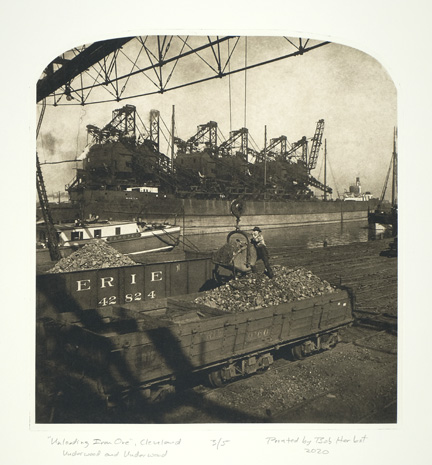
 |
| These historical pictures of Cleveland from the early 20th century are from vintage stereoview cards. I scanned one of the two images on each card, cleaned them up in Photoshop and made the photogravure printing plates from the files. These are hand-pulled photograures from polymer plates printed in an edition of 5. The image area is 10.75"W x 11.5"H. The print color is from a custom mix of 3 colors to match the original print color in the steroview card. |
|
|

"PUBLIC SQUARE", Cleveland 1919 Keystone View Co. Photogravure from polymer plate Image size 10-3/4 x 11-1/2 on 20x24 Stonehenge paper |
"PUBLIC SQUARE", Cleveland, 1919 (This text is printed on the reverse of the stereoview card) "We are in the very heart of Cleveland, county seat of Cuyahoga County, and fifth city in size in the United States. From the Public Square before us, with its great Soldiers' and Sailors' Monument and statue of General Cleveland, radiate the principal streets of the east side of the city, and to this Square converge the principal trolley lines. Here begins the famous Euclid Avenue, for some distance occupied by business houses, but farther out a handsome residential district, shaded by elms and maples and lined with palatial private homes surrounded by spacious grounds and gardens. The skyline of the business section of the city is broken by huge skyscrapers and by large department stores. The City Hall, Post Office, Chamber of Commerce and other public buildings, as well as fine hotels which provide every convenience and comfort are nearby. In the residential sections, remote from the roar of traffic, are to be found luxurious apartment houses, handsome churches, numerous parks and gardens, and broad, well-lighted, attractive drives. The situation of Cleveland, on the southern shore of Lake Erie, near the iron producing regions of the Great Lakes on the one hand, and the oil and coal of Pennsylvania on the other, has greatly favored the industrial and commercial development of the city. Some of the leading trunk lines of the railway system of the country pass through Cleveland, and there is immense lake traffic. Many of the ore docks and lumber yards are almost hidden on the fiat land bordering the Cuyahoga River, which empties into the lake." |
|
|
|
"UNLOADING IRON ORE", Cleveland circa 1915 (This text is printed on the reverse of the stereoview card) "We are looking northwest across the ship canal known as the "old river bed." That lake steamer over yonder and the nearer vessel at our left have come down from the western end of Lake Superior laden with ore from the biggest and richest iron mines on earth for great steel mills at Youngstown, Pittsburg or Wheeling. Now their holds are being emptied into freight cars for the overland portion of the journey. Railroad tracks like these run along the side of that farther pier beyond the S. S. Manila. A few years ago the unloading system which we see in operation directly before us was considered splendidly effective. That suspended bucket has been lowered into the vessel's hold and there filled, then lifted high enough to have a clear swing, drawn over here along that overhead trolley-beam, then lowered again for dumping. To-day it is better economy to use the up-to-date unloading apparatus 'which looms grotesquely in the air above that farther pier. There 5 to 10 tons of ore can be lifted in one load, and the work is done much more quickly than with these suspended "pockets." |

"UNLOADING IRON ORE", Cleveland circa 1915 Underwood and Underwood Photogravure from polymer plate Image size 10-3/4 x 11-1/2 on 20x24 Stonehenge paper |
|
|

"DECK OF AN ORE STEAMER", Cleveland circa 1915 Underwood and Underwood Photogravure from polymer plate Image size 10-3/4 x 11-1/2 on 20x24 Stonehenge paper |
"DECK OF AN ORE STEAMER", Cleveland circa 1915 (This text is printed on the reverse of the stereoview card) "We are standing on the deck of the steamer, W. R. Linn, alongside one of the great ore docks at Cleveland. This vessel has brought several thousand tons of iron ore down from the famous mining district at the head of Lake Superior, through Lake Huron and Lake Eric to this Ohio port. Here the cargo is being transferred to those stock-piles at the right, ready for railway shipment to the famous steel-mills in the Ohio valley 100 to 150 miles away-Youngstown, Pittsburg, Wheeling, etc. For many years the best unloading machinery took vessels like this from the Lake Superior mines down here to Lake Erie ports. The prospects are, however, that the Lake Superior region will, before long, be a strong rival of the Ohio Valley country in the manufacture of such raw material into pig iron and steel." |